Though Vertical has published two series by Keiko Takemiya, the Magnificent 49ers’ work remains largely unavailable in English, with a few exceptions: Yasuko Aoike’s From Eroica With Love (which debuted in 1976 in Akita Shoten), and Moto Hagio’s short stories “A, A’ [A, A Prime],” “4/4 [Quatre/Quarts],” “X+Y,” and “They Were Eleven.”* These four stories comprise a mere 330 pages of material, but they offer readers a window into a key stage in shojo manga’s development, when women artists began pushing the medium in new directions, visually and thematically. Hagio’s work, like Takemiya’s, is unabashedly Romantic, filled with yearning characters who are struggling to uncover their true selves, even when that quest puts them at odds with societal norms. Though there is an intense, adolescent sensibility to some of her stories, that — for me, at least — is part of their beauty; Hagio clearly remembers what it feels like to be sixteen or eighteen, yet the way she frames those emotions is so exquisite and refined that the reader can appreciate her craft, even if the drama seems a little overripe from an adult perspective.
If you’ve been curious about what Takemiya’s peers were doing while she was writing To Terra and Song of the Wind and the Trees, or are wondering what to expect if you purchase Hagio’s A Drunken Dream this fall, read on.
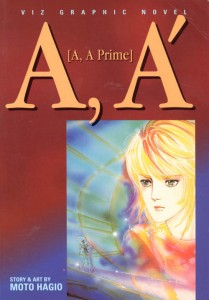 A, A’ [A, A Prime]
A, A’ [A, A Prime]
This sometimes lyrical, sometimes bizarre anthology contains three interrelated stories. In the first, “A, A’, [A, A Prime],” a group of researchers struggle to accept Addy, a new team member who is, in fact, the clone of a colleague who perished several years earlier; in the second, “4/4 [Quatre/Quarts],” Mori, a telepath, becomes obsessed with Trill, a strange young woman who’s virtually mute; and in the third, “X+Y,” a now-older Mori falls in love with Tacto, an androgynous young man who resembles Trill. Addy, Trill, and Tacto are Unicorns, a humanoid species bred for deep-space travel. Though Unicorns share common physical characteristics — most notably a shock of red hair running down the center of their heads — and high IQs — their original purpose was to serve as computer technicians on long space missions — they have a hard time negotiating the human world: emotions baffle them, and the act of forming deep attachments to other people can destabilize their personalities.
Though Hagio rehearses some time-honored sci-fi tropes — especially the danger of genetic tampering — one of her most striking themes is the relationship between memory and identity. Addy, for example, is born with all of her predecessor’s memories of childhood, but none of her predecessor’s memories of Proxima, the remote ice world where the original Addy worked for three years before dying in an accident. That gap in Addy’s memory proves especially difficult for her co-worker Regg, who had been romantically involved with Addy’s predecessor. Addy has no idea who he is, and is bewildered that Regg knows about events from her “childhood” — events that Addy hasn’t discussed with anyone. More troubling still, these “memories” are deeply upsetting, even though Addy knows she isn’t reliving her own history.
Tacto, on the other hand, teeters on the verge of a breakdown because his memory is incomplete. As a young child, he stumbled across a gruesome sight, one which his father attempted to erase from Tacto’s memory. That seemingly humane gesture backfired, however, leaving Tacto with only an emotional echo of the traumatic event and no concrete information about what he’d actually seen; only by recovering those painful memories does Tacto escape his emotional paralysis and embrace Mori’s love for him.
Hagio’s artwork supports the intensely Romantic quality of all three stories, as she represents her characters’ memories with symbolically rich imagery. In “4/4,” for example, Trill is haunted by a recurring vision of corpses, each fastened to the floor with a lepidopterist’s pin — Trill’s memory of numerous, unsuccessful attempts to clone her. (Dr. Sazzan, her caretaker, is obsessed with breeding more Unicorns.) Tacto’s unformed memory of his childhood resembles the nightmare paintings of John Fuselli; Tacto sees a disembodied, demonic face emerge from the rocky surface of an asteroid, a swirling black cloud with eyes and a terrible mouth.
That dream-like quality extends to the settings as well, which mirror the characters’ turbulent emotional states. Trill and Mori, for example, visit a spectacular aviary aboard a space station; it’s a lush, erotically charged setting evocative of a Rousseau painting, and one that suggests the intensity of Mori’s desire for Trill. Hagio performs a similar trick in this sequence, transforming an interstellar reconnaissance mission into an intimate windsailing expedition through the stars:
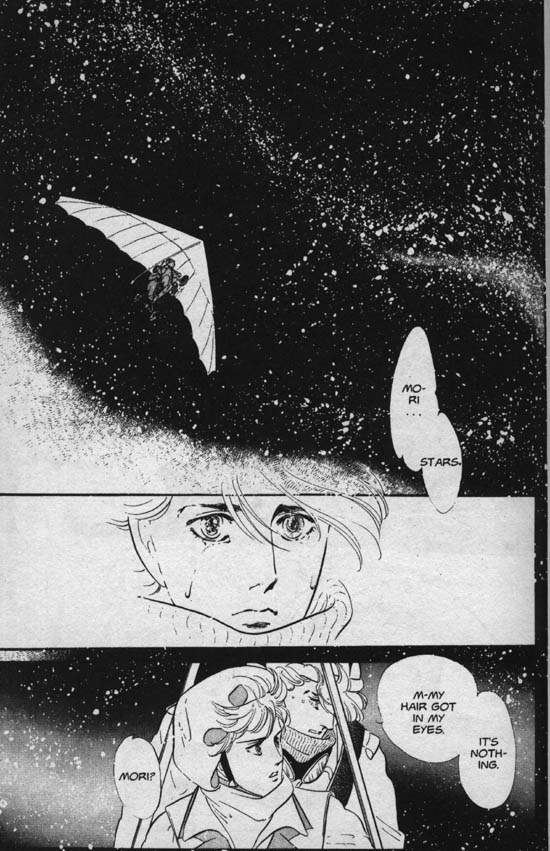
Lest A, A’ sound like The Unbearable Lightness of Being in Space, let me assure you that Hagio demonstrates a unique ability to mix the sublime with the ridiculous. Her characters’ names, for example, are just about as goofy as they come: Dr. Wright Moonsault. Regg Bone. Marble. Professor Sazzan. Their costumes, too, have the same overripe quality as the names, with men sporting headbands, half capes, tall boots, and Renn Fair hats, and women clad in off-the-shoulder jumpsuits. The subplots take the cake, however, for their sheer moonbattiness: in “X+Y,” for example, Tacto’s father invents a temporary sex change drug that enables a male colleague to become pregnant, a subplot that actually holds the key to unlocking Tacto’s past.
Now out of print, VIZ originally released A, A’ in 1997. Expect to pay about $25.00 for a decent used copy if you choose to buy it online through ALibris or Amazon’s network of retailers. You might also try the library or your local comic shop’s bargain bin.
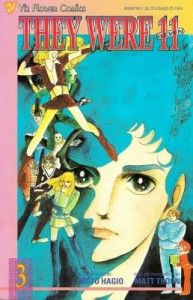 THEY WERE ELEVEN
THEY WERE ELEVEN
Ten cadets at an interstellar space academy are dispatched to a decommissioned ship. Their task: remain on board for 53 days without pressing the panic button; if they persevere, all ten will pass their final exam. Once aboard the ship, however, the cadets realize something is amiss. Not only do they have an extra crew member, but a series of mechanical failures and explosions threaten to send the ship hurtling into the surface of a neighboring star.
Though the premise could be spun out in the manner of, say, Event Horizon, Hagio favors a Gene Rodenberry approach, emphasizing character development and social commentary over gunplay, robots, or totally icky alien life forms. (You know the kind: they embed themselves in your chest cavity, hunt you down like a rabbit, or just spray toxic venom in your face.) Like the good astronauts of the starship Enterprise, They Were Eleven‘s cast are humanoids of various shapes and sizes. A few seem empathic; one has remarkable healing powers; another is tall and scaly; yet another looks like a distant relative of The Thing; and one pretty character has yet to decide whether it will develop into a man or woman. The dilemmas the cadets face — technical, social, and medical — also place us firmly in Star Trek territory, inspiring the characters to ruminate on issues as varied as gender roles and the ethics of sacrificing an individual for the good of the collective.
In fact, the exploration of gender is one of They Were Eleven‘s most interesting subplots; Frol, the sexually indeterminate member of the crew, is furious that her shipmates construe her as female. “I hate women!” she shouts. “Women are nothing but a waste of space!” Midway through the story, Hagio reveals the source of Frol’s misogyny: her parents want her to become the ninth wife of a prominent nobleman. If Frol passes the Galactic Academy exam, however, she will earn the right to become a man, a privilege usually reserved for a family’s eldest child. (Frol’s people are born hermaphrodites, becoming male or female only in adulthood.) Hagio’s critique of gender roles is both obvious and sly — obvious, in that Frol’s objection to being a woman stems from the division of labor on her home world (men rule the roost; women do all the work and bear lots of children) and sly, in that Hagio uses primogeniture as a metaphor for the broader sense of entitlement that comes with being born male.
If Hagio’s aliens are strictly by the Star Trek book, all funny foreheads and funky hides, her layouts are stunning, punctuated by several arresting, full-page images: an enormous hall of cadets taking their exams (each in a groovy, womb-like isolation pod to prevent cheating), a picture of the dying star around which the test ship is orbiting, a character’s profile dissolving into a trail of stars. Hagio juxtaposes these expansive images with long, almost claustrophobically tight scenes of shipmates bickering and coping with the latest mechanical failures. It’s a neat trick, giving us a sense of how tight quarters really are aboard the White, and suggesting how that small space exacerbates tensions among the crew. And oh, those interiors! Like Takemiya, Hagio loves to draw detailed banks of computers and rows of tubes and wires and pipes, bringing the ship to vivid life. (Or, perhaps more accurately in the case of They Were Eleven, showing the ship in all its decrepitude.)
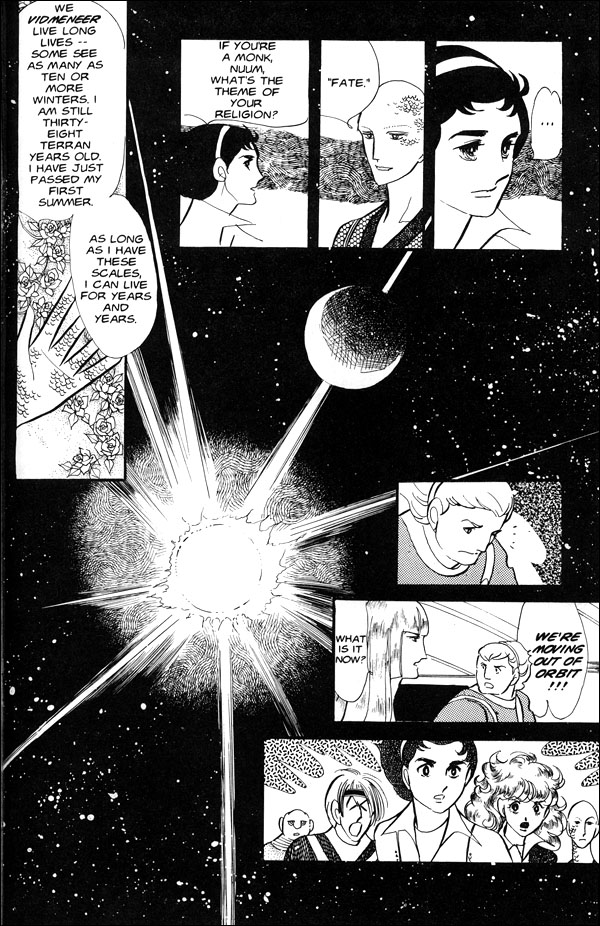
Much as I would like to recommend They Were Eleven, the story is out of print in English. In the mid-1990s, VIZ issued it in two forms: as a four-issue comic (1995), and in the anthology Four Shojo Stories (1996). Used book dealers have gotten wise to the scarcity of this title; copies of Four Shojo Stories generally retail for $60 and up. Though I didn’t have too much difficulty scaring up the old VIZ Flower floppies on eBay (and I rather enjoyed the American-style presentation), it would be great to see this chestnut re-issued for a generation of readers who think that Black Bird is the first and last word in girls’ comics.
* Hagio’s story “Hanshin” was reprinted in The Comics Journal‘s shojo manga issue from 2005 (no. 269). For the purposes of this essay, I’m focusing on Hagio’s commercially available work. And speaking of work by pioneering shojo artists, Swan, which ran in Margaret from 1976 to 1981, is also available in English (CMX), and is the work of artist Kyoko Ariyoshi, who was born in 1950.
This an expanded version of a review that originally appeared at PopCultureShock on 1/20/07.
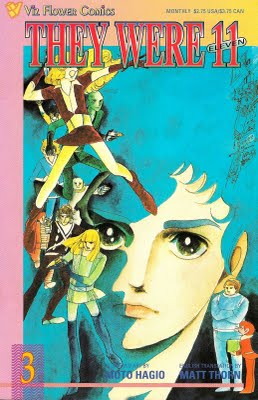


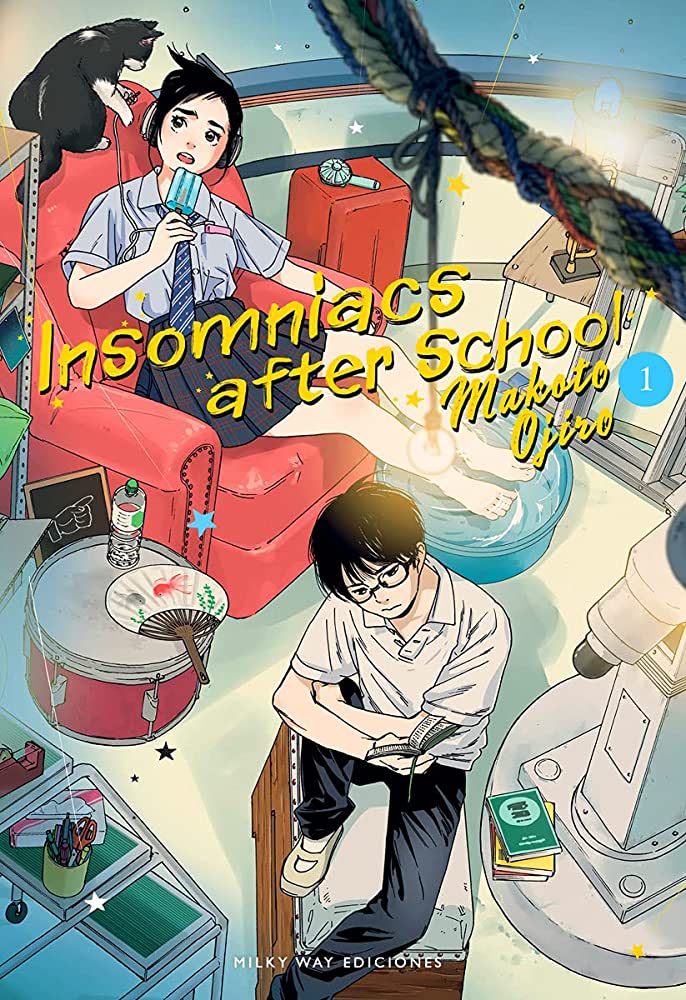
CJ says:
I’ve gotten to see the They Were 11 movie, it was really good, I think if someone can’t get ahold of Four Shojo Stories, they should at least be sure to watch the must easier to find movie.
Katherine Dacey says:
Thanks for the suggestion, CJ! Am I right in thinking the movie adaptation is pretty short (about 40 minutes)?
CJ says:
Nope, movie is actually 91 minutes (going based on amazon listing here, which sounds about right). I don’t think it felt bogged down with filler either though, compared to the manga, some scenes are extended, like the chasing Tada scene is quite a bit longer but not to the point where it’s too long, and I guess the movie overall takes things a bit slower, but I read the manga last night to see and it felt like the manga moved too fast at times. It’s still a good adaptation worth checking out, it fills its time well and one of the only added scenes off the top of my head that wasn’t an extension of a previous scene for clarity is a short food fight for relaxation.
Katherine Dacey says:
Thanks for the intel, CJ. I’ll have to see if I can get my hands on the anime!
ed says:
Hmm… the Magnificent 49ers’ work remains largely unavailable in English, with one notable exception: Moto Hagio
I was wondering if it could be possible to make note that Yasuko Aoike is also a 49er? More than a dozen volumes of Erica are available, many of which were published before this piece was first appeared at PCS.
Katherine Dacey says:
Oops—the phrasing is misleading there, Ed. I’ll fix that. I was so focused on the fabulous ladies of sci-fi that I forgot that From Eroica With Love debuted in 1976, right around the same time as Hagio and Takemiya were publishing the stories we discussed in the roundtable. Thanks for the catch!
For anyone wondering who belongs to the Year 24 Group (a.k.a. the Magnificent 49ers), you’ll find a help list here: http://myanimelist.net/clubs.php?cid=5405.
Eric Henwood-Greer says:
Terrific review of my all time fave manga-ka (man am I glad I got Four Shojo Stories when it first came out as a junior high student). I wish we could get a translation of the intriguing sounding sequels to They Were 11—there was the major 170 page one from the following year, 1976, Horizon of the East, Eternity of the West, and the 30 page, Tada and Frol’s Space Street from 1977 which is more like a series of short, comic vignettes.
One really anal detail—A A` isn’t from the 70s—but from the 80s (I believe the title story was published in Princess Magazine in 1981, 4/4 is from Petit Flower in ’83, and X+Y from Petit Flower in ’84—I know in Japan the stories have been collected in a few different formats).
Katherine Dacey says:
Hi, Eric! Thanks for the feedback and for the correction vis-a-vis the original publication dates for the stories in A, A’ — I’ve fixed the text. I don’t know if you’ve had a chance to look at A Drunken Dream yet, but it’s fantastic. Matt Thorn also edited and translated the text, and he really does justice to Hagio’s writing. It’s easily the best thing I’ve read this year, graphic novel-wise.
Eric Henwood-Greer says:
No worries—just glad I didn’t sound too much like a grumpy pedant. For the longest time I tried to find out exactly what date the A A` stories were from — this is me being anal again, but it drove me crazy how those older manga editions of Viz, never had the original dates (actually this is a problem in a lot of translated manga).
The combo of getting Four Shojo Stories, and then A A` (and to a lesser extent the Keiko Nishi collection Love Song which was also from Matt Thorn), all at around the age of 15, is truly the root of my manga fandom. For a while it seemed Viz really was going to work on classic shojo titles—I believe the next year Matt Thorn started the translation of Banana Fish (which took a good ten years to finally all come out, Matt only doing the early vols)—and then we got next to nothing in the way of classic manga for a long while…
I have A Drunken Dream on pre-order. Trust me, it’s already taking all my restraint not to look at the various online sample pages—I can’t tell you how excited I am for it… I know it also reprints Matt’s *awesome* interview with Hagio from the Comic Journal, my copy of which I’ve read probably a half dozen times (I’m especially thankful for the fairly detailed bibliography, in English, it has for Hagio—something I wish we had an equivalent one for Takemiya and a few other artists from that time…)
One random thought (sorry ^^;;) in re-reading your comments on They Were 11 – surely it was a big influence on the spaceship/past lives part of Please Save My Earth? There just seem to be so many parallels.
And as for the recommendation above about seeing the They Were 11 anime if you can’t track down the manga, I have to say it’s a very faithful, and good adaptation—and definitely worthwhile tracking down for any fan who can’t find the manga. A part of me almost wishes it was less faithful, as it seems a tad by the numbers. On the other hand the art feels VERY different from Hagio’s manga, even with similar character designs—there’s little of the attempt that the 1980 To Terra movie, for example, tried, to get down in animated terms the classic shoujo beauty and abstraction of the manga—not tomention other Takemiya adaptations like the low budget TV special Andromeda Stories or the poignant Song of Wind and Trees adaptation. (Ironic as it was directed by the brother of Osamu Dezaki, when Osamu himself woulda been a better choice since he was so masterful at catching that 70s manga aesthetic in animated terms with his two adaptations of Riyoko Ikeda 1970s classics—Rose of Versailles and Oniisama E).